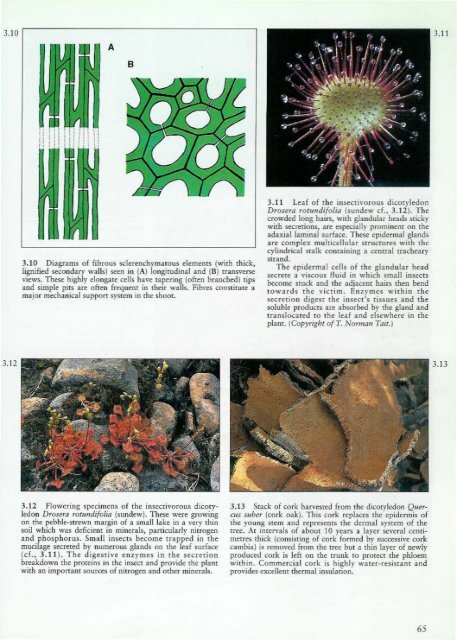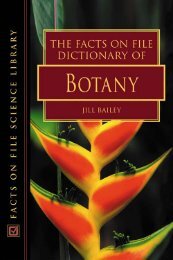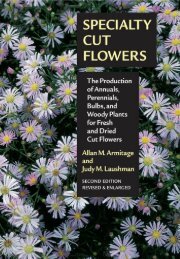You also want an ePaper? Increase the reach of your titles
YUMPU automatically turns print PDFs into web optimized ePapers that Google loves.
3.10<br />
3.12<br />
A<br />
B<br />
3.10 Diagrams of fibrous sderenchymatous dements (with thick,<br />
lignified seconduy walls) setn in (A) longitudinal and (B) transverse<br />
views. These highly elongare cells have lapering (often branched) lips<br />
and simple pirs are often frequem in tbeir walls. Fibres constitute a<br />
major mechanical support syStem In the shoot.<br />
3.12 Flowering specimens of the insectivorous dICOtyledon<br />
Dros(!ra rotundifolitI (sundew). These were growing<br />
on the pebble·strewn margin of a small lake in a very thin<br />
soil which was deficient in minerals. panicularlr nitrogen<br />
and phosphorus. Small insecl5 become trapped in the<br />
mucilage secreted by numerous glands on rhe leaf surface<br />
jci., 3. t t). The digestive enzymes in the secretion<br />
breakdown the proteins in rhe insect and provide the plant<br />
with an important sources of nitrogen and other minerals.<br />
3.11 Leaf of the insec£ivorous dicotyledon<br />
Droura rotundifolia (sundew d., 3.12). The<br />
crowd«i long hairs, with glandular heads stick}'<br />
....ith secretions, are especially prominent on the<br />
adaxiallaminal surface. These epidermal glands<br />
are complex multicellular Structures with the<br />
qlindric.al stalk containing a cenrral rracheary<br />
strand.<br />
The epidermal cells of the glandular head<br />
secrete a viscous fluid in which small insects<br />
!xc::ome srock and the adjacent hairs then bend<br />
towards the victim. Enzymes within the<br />
secretion digest the insect's tissues and the<br />
soluble products are absorbed by the gland and<br />
tunslocated co the leaf and elsewhere in the<br />
plant. (Copyright ofT. Norman Tml.)<br />
3.13 Stack of cork harvested from the dicotyledon Quercus<br />
suber (cork oak). This cork replaces the epidermis of<br />
the young sum and represents the dermal srstem of the<br />
tn:e. At intervals of about 10 years a layer several centimetres<br />
thick (consisting of cork formed br successive cork<br />
cambia) is removed from the tree but a min layer of newly<br />
produced cork is left on the trunk to protect the phloem<br />
within. Commercial cork is highlr water-resistant and<br />
provides excellent thermal insulation.<br />
65<br />
3.11<br />
3.13





